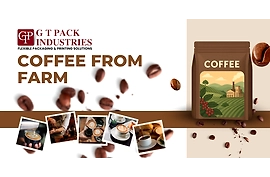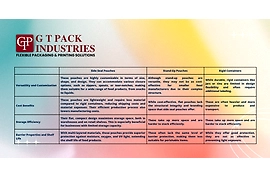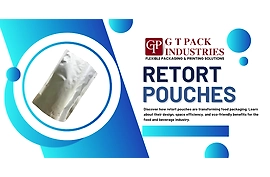Step-by-Step Guide to Effectively Using Packaging Pouches in Printing
| 12 Sep 2024
Packaging pouches are a game-changer in the printing industry, offering flexibility, protection, and branding opportunities. Packaging pouches have revolutionized the printing and packaging industry, offering a wide range of benefits such as improved product protection, portability, and customizability. But, as with any product, using packaging pouches effectively involves following certain best practices and troubleshooting common issues. In this guide, we’ll break down the process to help you get the most out of packaging pouches for your printing projects.
Step 1: Choose the Right Type of Packaging Pouch
Before you start printing, you need to choose the right type of packaging material or packaging pouch for your product. Packaging pouches come in various styles, and each one has different uses based on its material, shape, and sealing methods. The most common types are:
1. Stand-Up Pouches
Ideal for: Products that need to stand upright on store shelves, like snacks, coffee, or pet food.
Stand-up pouches are one of the most popular types of packaging used in various industries. They feature a bottom gusset that allows them to stand upright, making them ideal for both storage and presentation on retail shelves. These pouches are often used for food products like chips, granola, dried fruits, nuts, coffee beans, and even non-food items like detergents and pet treats.
Advantages:
-
Excellent Shelf Visibility: Stand-up pouches maximize shelf space and draw attention due to their vertical presentation.
-
Durability and Protection: Most stand-up pouches come with multi-layered barriers that protect the contents from moisture, oxygen, and UV light, extending the shelf life of perishable products.
-
Customizable: These pouches are easy to customize with zippers, tear notches, and transparent windows, giving consumers added convenience and visual appeal.
Best for:
-
Snack foods (chips, popcorn, cookies)
-
Coffee and tea (whole beans or ground)
-
Granola and cereals
-
Pet food and treats
-
Cleaning products like laundry pods or dishwasher tabs
2. Flat Pouches (Pillow Pouches)
Ideal for: Small items like candy, single-serve snacks, cosmetics, or individual-use products like wet wipes.
Flat pouches, often referred to as pillow pouches, are single-use, non-resealable packaging types. These pouches are usually lightweight and compact, making them perfect for products where portability and single servings are important. Flat pouches are widely used in the snack industry, as well as for medical supplies and cosmetics.
Advantages:
-
Cost-Effective: Because flat pouches use less material than stand-up pouches or other packaging options, they tend to be more affordable to produce, especially for large-volume production.
-
Great for Small, Lightweight Items: Flat pouches are an excellent choice for packaging products that don’t require a rigid structure or much protection from external factors like humidity or sunlight.
-
Compact and Portable: Their slim design makes them easy to store and carry, perfect for single-use products or portion-controlled packaging.
Best for:
-
Candy (mints, gummies, hard candies)
-
Individual serving snacks (chips, granola bars, dried fruits)
-
Sample-sized cosmetics (face creams, serums, face masks)
-
Wet wipes or sanitizing wipes
-
Small medical supplies (band-aids, alcohol pads)
3. Spout Pouches
Ideal for: Liquids, semi-liquids, or pourable products like sauces, soups, beverages, and personal care items like shampoo.
Spout pouches are a versatile packaging option for liquids and semi-liquids. They have an integrated spout and cap that make it easy for consumers to pour out or squeeze the contents. Spout pouches are often seen in the food and beverage industry, but they are also making waves in sectors like personal care (shampoos, lotions) and household products (laundry detergent).
Advantages:
-
Convenient and Resealable: The built-in spout and cap make it easy for users to reseal the pouch after each use, keeping the product fresh for longer.
-
Eco-Friendly Alternative to Bottles: Spout pouches use less plastic than rigid bottles, making them an environmentally friendly option. They also weigh less and take up less space during transportation, reducing carbon emissions.
-
Space-Efficient Storage: These pouches can stand up straight, which makes them easy to store on shelves or in fridges, depending on the product.
Best for:
-
Liquid food products (ketchup, sauces, syrups, honey, salad dressing)
-
Beverages (juice, smoothies, energy drinks)
-
Semi-liquid personal care items (shampoo, body wash, hand lotion)
-
Industrial products (motor oil, cleaning fluids, laundry detergent)
-
Baby food (purees and yogurt)
4. Vacuum Pouches
Ideal for: Products that require vacuum-sealing, such as meat, seafood, cheese, or other perishables that need to stay fresh for longer periods.
Vacuum pouches are specially designed to keep air out, which extends the shelf life of the product and preserves freshness. By vacuum-sealing the contents, these pouches prevent oxygen from entering, which significantly reduces the risk of spoilage and bacterial growth. Vacuum pouches are widely used in the food industry, especially for perishable items like meats, seafood, and cheeses.
Advantages:
-
Extended Shelf Life: The vacuum-sealing process helps preserve food products by eliminating the air that contributes to spoilage. This makes them ideal for long-term storage and shipping.
-
Prevents Freezer Burn: For frozen items like meats, vacuum pouches help prevent freezer burn, ensuring the product stays fresh longer and maintains its quality.
-
Strong Barrier Protection: These pouches often include multiple layers that provide strong protection from moisture, oxygen, and UV light, which can degrade the quality of sensitive products.
Best for:
-
Fresh or frozen meat (beef, poultry, pork, fish)
-
Cheese and dairy products
-
Cured and processed meats (bacon, ham, sausages)
-
Prepared foods (ready-to-eat meals, soups, stews)
-
Dried fruits and nuts that need long-term storage
Packaging pouches offer incredible flexibility and functionality, allowing companies to cater to various product needs while also offering visually appealing and consumer-friendly options. Whether you're working with liquids, powders, or perishable goods, there's a pouch type designed to protect your product and enhance the consumer's experience. By choosing the right type of pouch, you're not only safeguarding the quality of your product but also ensuring that it stands out on crowded store shelves.
Tip: Consider the product you're packaging, the filling process, and the storage conditions before selecting your pouch. Think about whether the pouch will need additional barriers like UV protection or moisture resistance.
Step 2: Prepare the Artwork and Design
Once you've chosen your pouch, it’s time to design the artwork that will be printed on the surface. The design process for packaging pouches can be a little different from traditional printing because you’re working on a flexible surface that may need to withstand folding and filling.
Key Considerations for Design:
-
Size and shape of the pouch: Ensure your design fits well on the pouch and doesn’t get distorted when the pouch is filled.
-
Bleed and trim areas: Account for areas that may be trimmed during the manufacturing process.
-
Color profiles: Use the CMYK color model to ensure accurate color reproduction.
-
Resolution: Use high-resolution images (300 DPI or higher) to avoid pixelation.
-
Branding and product information: Make sure your logo, product name, and other essential info like weight or nutritional details are clearly visible.
Tip: Re-check your artwork dimensions and make sure you're accounting for bleed and trim lines. Run a test print and adjust as needed.
Step 3: Choose the Right Printing Method
There are several printing methods available for packaging pouches. The best method depends on the size of your print run, the material of the pouch, and your budget.
Popular Printing Methods:
-
Gravure printing: Known for its high-quality output and durability. It's ideal for large runs but may be costly for small batches.
-
Flexographic printing: Another great option for larger print runs, offering good quality at a reasonable price.
-
Digital printing: Best for small runs or projects with complex designs. Digital printing allows for quick changes and short turnaround times.
Tip: If you're just starting out or working with smaller quantities, digital printing may be your best bet. Flexographic and gravure printing are more suited to larger-scale projects.
Step 4: Set Up the Printing Machine
Now that you’ve got your pouch and design ready, it’s time to set up the printing machine. This step will vary depending on the type of machine you're using, but the general process is fairly consistent.
-
Color matching is the most important segment of the printing setup for laminated packaging pouches.
-
Load the packaging material or pouches into the machine’s input area for printing. In digital printing direct pouches are fed into a printer tray for printing whereas, in the traditional form of printing technology, there is a set process of printing of outer later.
-
Adjust the settings for temperature, pressure, and speed. These settings depend on the pouch material and the type of ink you're using.
-
Test run: Always run a small batch first to check alignment, color accuracy, and print quality.
Tip: Double-check your settings and run a few more test pouches if the ink is smudging or the colors seem off. Also, make sure the pouches are clean and free from dust or debris, as this can impact print quality.
Step 5: Post-Printing Processes (Lamination, Cutting, Sealing)
After printing, packaging pouches often go through additional steps such as lamination or sealing.
-
Lamination: This process adds an extra layer of protection to the printed design. It helps to preserve colors and adds durability.
-
Cutting and sealing: If you're printing on a roll of material, you’ll need to cut the pouches to their desired size and seal the edges to form the final product.
Tip: Test the sealing process carefully. Poor sealing can lead to leaks, which is a major issue for products like liquids or powdered goods.
Wrapping It Up
Printing on packaging pouches offers a great way to create eye-catching, functional packaging that protects your products. By following the steps outlined in this guide, you can ensure that your pouch printing process goes smoothly. Remember, preparation is key: choose the right pouch, design carefully, and troubleshoot common issues early. Happy printing!
FAQs on Using Packaging Pouches in Printing
1. What type of pouch should I use for food packaging?
Stand-up pouches with resealable zippers are a popular choice for food products. They help keep the product fresh and allow customers to reuse the packaging.
2. Can I print on both sides of the pouch?
Yes, you can print on both sides of most pouches. However, make sure your design elements are aligned and won’t be distorted by folding or filling.
3. What is the best printing method for small orders?
Digital printing is ideal for small orders because it doesn’t require expensive plates or setup fees, making it more cost-effective for low-volume projects.
4. How do I prevent ink from smudging during the printing process?
Ensure that the pouch surface is clean and free from dust or oils. You should also check that your ink is compatible with the pouch material and that the machine settings are correct for your chosen printing method.
5. How long does it take for the ink to dry on packaging pouches?
The drying time depends on the type of ink and the material of the pouch. Some inks may require heat curing, while others may air-dry. Digital inks tend to dry faster than flexographic or gravure inks.







